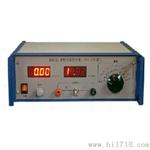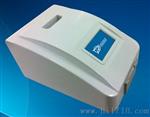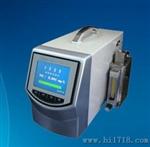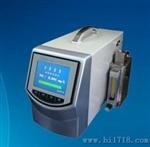本产品型号:-121
一,仪器特征:
本仪器测量采用三电法对试样进行测试,其试验装置主要有平板式电装置和高阻计两部分组成。基本原理是对试样加入不同挡位的直流电压,流经试样的微弱电流用标准电阻取样放大后,从高阻计上读出。数字直接显示出电阻值,高、显示、稳定性好、读数方便。
二:仪器合的标准有:
☆ GB/T 1410-2006 固体缘材料 体积电阻率和表面电阻率试验方法 ☆ GB 12014 静电工作服☆ GB/T 20991-2007 个体护装备 鞋的测试方法☆ GB 4385-1995 静电鞋、导电鞋技术要求☆ GB 12158-2006 静电事故通用导则 ☆ GB 4655-2003 橡胶工业静电规程☆ GB/T 12703.4-2010 纺织品 静电性能的评定 ☆ GB/T 12703.6-2010 纺织品 静电性能的评定☆ GB 液体石油产品静电规程 ☆ GB/T 导电和静电纤维增强塑料电阻率试验方法☆ GB/T 地毯 静电习性评价法 行走试验 ☆ GB/T 硫化橡胶 工业用静电和导电产品 电阻限范围☆ GB/T 22042-2008 服装 静电性能 表面电阻率试验方法 ☆ GB/T 22043-2008 服装 静电性能 通过材料的电阻(垂直电阻)试验方法☆ GB/T 24249-2009 静电洁净织物 ☆ GB 26539-2011 静电陶瓷砖 Antistatic ceramic til☆ GB/T 26825-2011 静电腐胶 ☆ GB 50515-2010 导()静电地面设计规范☆ GB 50611-2010 电子工程静电设计规范 ☆ G 105-1998-Z 电子产品静电放电控制手册☆ G 3007A-2009 静电工作区技术要求 ☆ G 5104-2004 无线电引信风帽用静电涂料及风帽静电性能通用要求
三:仪器技术指标:
1.电阻测量范围: 0.01×104Ω ~1×1018Ω。 2.电流测量范围为: 2×10-4A~1×10-16A3. 双表头显示: 3.1/2位LED显示 4. 内置测试电压: 10V、50V、100V、250、500、1000V5. 基本准确度:1% (*注) 6 使用环境: 温度:0℃~40℃,相对湿度<80%7 机内测试电压: 10/50/100/250/500/1000V 任意切换 8.供电形式: AC 220V,50HZ,功耗约5W
附加介绍:电阻率
电阻率是用来表示各种物质电阻特性的物理量。某种材料制成的长1米、横截面积是1平方毫米的在常温下(20℃时)导线的电阻,叫做这种材料的电阻率。电阻率的单位是欧姆·米(Ω·m或ohmm),常用单位是欧姆·毫米和欧姆·米。应用电阻率较低的物质被称为导体,常见导体主要为金属,而自然界中导电性的是银,其次为半导体,、硅锗。当存在外电场时,金属的自由电子在运动中不断和晶格节点上做热振子的正离子相碰撞,使电子运动受到阻碍,因而就具有了的电阻。其他不易导电的物质如玻璃、橡胶等,电阻率较高,一般称为缘体。介于导体和缘体之间的物质(如硅) 则称半导体。电阻率的科学号为 ρ(Rho)。 已知物体的电阻,可由电阻率ρ、长度 l 与截面面积A 计算:ρ=RA/I,在该式中, 电阻R 单位为欧姆,长度 l 单位为米,截面面积 A 单位为平方米,电阻率 ρ单位为欧姆·米计算公式电阻率的计算公式为:ρ=RS/Lρ为电阻率——常用单位Ω·mS为横截面积——常用单位㎡R为电阻值——常用单位ΩL为导线的长度——常用单位m-----------------------------------------电阻率的另一计算公式为:ρ=E/Jρ为电阻率——常用单位Ω·mm2/m[1]E为电场强度——常用单位N/CJ为电流密度——常用单位A/㎡(E,J 可以为矢量)说明1.电阻率ρ不和导体的材料有关,还和导体的温度有关。在温度变化不大的范围内:几乎金属的电阻率随温度作线性变化,即ρ=ρo(1+at)。式中t是摄氏温度,ρo是O℃时的电阻率,a是电阻率温度系数。2.由于电阻率随温度改变而改变,所以对于某些电器的电阻,须说明它们所处的物理状态。如一个220 V -100 W电灯灯丝的电阻,通电时是484欧姆,未通电时只有40欧姆左右。3.电阻率和电阻是两个不同的概念。电阻率是反映物质对电流阻碍作用的属性,电阻是反映物体对电流阻碍作用的属性。金属导体常用电阻率材料电阻率(Ω m)(1)银1.65 ×10-8(2)铜1.75 ×10-8(3)金2.40×10-8(4)铝2.83 ×10-8(5钨5.48 ×10-8(6)铁9.78 ×10-8(7)铂2.22 ×10-7(8)锰铜4.4 ×10-7(9)汞9.6 ×10-7(10)康铜5.0 ×10-7(11)镍铬合金1.0 ×10-6(12)铁铬铝合金1.4 ×10-6(13) 铝镍铁合金1.6 ×10-6可以看出金属的电阻率较小,合金的电阻率较大,非金属和一些金属氧化物更大,而缘体的电阻率大。锗、硅、硒、氧化铜、硼等的电阻率比缘体小而比金属大,我们把这类材料叫做半导体(semiconductors)。总结:常态下(由表可知)导电性能的依次是银、铜、铝,这三种材料是常用的,常被用来作为导线等,其中铜用的为广,几乎现在的导线都是铜的(精密仪器,场合除外)铝线由于化学性质不稳定容易氧化已被淘汰。由于铝密度小,取材广泛,且价格比铜便宜,目前被广泛用于电力系统中传输电力的架空输电线路。为解决铝材刚性不足缺陷,一般采用钢芯铝绞线,即铝绞线内部包有一根钢线,以强度。银导电性能,但由于成本高很少被采用,只有在高要求场合才被使用,如精密仪器、高频震荡器、航天等。顺便说下金,在某些场合仪器上触点也有用金的,那是因为金的化学性质稳定故采用,并不是因为其电阻率小所致。金属和非金属的电阻率金属温度(℃) ραo (×10-3Ω·m), 100 (×10-3Ω·m)锌20 5.9 4.2铝(软)20 2.75 4.2铝(软)–78 1.64石墨(8~13)×10-6阿露美尔合金20 33 1.2锑0 38.7 5.4铱20 6.5 3.9铟0 8.2 5.1殷钢0 75 2锇20 9.5 4.2镉20 7.4 4.2钾20 6.9 5.1①钙 20 4.6 3.3金20 2.4 4.0银20 1.62 4.1铬(软)20 17镍铬合金(克露美尔)— 70—110 .11—。54钴a 0 6.37 6.58康铜— 50 –。04–1.01锆30 49 4.0黄铜– 5—7 1.4–2水银0 94.08 0.99水银20 95.8锡20 11.4 4.5锶0 30.3 3.5青铜– 13—18 0.5铯20 21 4.8铋20 120 4.520 19 5钨20 5.5 5.3钨1000 35钨钨–78 3.2钽20 15 3.5金 属温度(0℃) ραo , 100杜拉铝(软)— 3.4铁(纯)20 9.8 6.6铁(纯)–78 4.9铁(钢)— 10—20 1.5—5铁(铸)— 57—114铜(软)20 1.72 4.3铜(软)100 2.28铜(软)–78 1.03铜(软)–183 0.30钍20 18 2.4钠20 4.6 5.5①铅 20 21 4.2镍铬合金(铁)20 109 .10镍铬合金(含铁)20 95—104 .3—。5镍铬林合金— 27—45 .2—。34镍(软)20 7.24 6.7镍(软)–78 3.9铂20 10.6 3.9铂1000 43铂–78 6.7铂铑合金②20 22 1.4钯20 10.8 3.7砷20 35 3.9镍铜锌电阻线—34—41 .25—。32铍(软)20 6.4镁20 4.5 4.0锰铜20 42—48 –03—+.02钼20 5.6 4.4洋银— 17—41 .4—。38锂20 9.4 4.6磷青铜— 2—6铷20 12.5 5.5铑20 5.1 4.4
①0℃和融点间的平均温度系数 ②铂90%,铑10% *若电阻率单位用欧姆厘米(Ωcm )表示,表中数值应扩大100倍。
Beijing Beiguang precision instrument and Equipment Co., Ltd. is specialized in producing all kinds of detection equipment producers of Beijing, the instrument of good quality, reasonable price cheap, after sale servic, each instrument will have profsional engineers on-site commissioning training.
Product Name: Volume surface ristivity tter, insulation tter volume ristivity tt material, the surface ristivity of solid and liquid material tter
This product te: -121
A, instrument characteristics:
This instrument is measured by three electrod method to tt sampl, the tt device mainly consists of a flat electrode device and high ristance meter is composed of two parts. The basic principle is the DC voltage to different plac to sample addition, weak current through the sample with standard ristor sampling amplification, from high ristance meter reading. Dial display value of ristance, high precision, good stability, shows a rapid, convenient reading.
Two: the instrument conforms to the standards:
Tt method for volume ristivity and surface ristivity of solid insulating materials or GB/T 1410-2006
☆ GB 12014 anti-static overalls
Tt method GB/T 20991-2007 wear personal protective equipment sho
☆ GB 4385-1995 anti-static sho, conductive sho technical requirements
☆ GB 12158-2006 general guideline for preventing electrostatic accidents
☆ GB 4655-2003 rubber industrial safety rul of static electricity
Evaluation of GB/T 12703.4-2010 or textile electrostatic properti.
Evaluation of GB/T 12703.6-2010 or textile electrostatic properti.
☆ GB liquid petroleum product safety rul of static electricity
Tt methods of plastic or GB/T 15738-2008 ristivity of conducting and antistatic fiber reinforced
☆ GB/T carpet electrostatic behavior evaluation walking tt
Antistatic and conductive products electrical ristance limits with ☆ GB/T 18864-2002 vulcanized rubber industry
☆ GB/T 22042-2008 clothing - Tt Method for electrostatic properti of surface ristivity
☆ GB/T 22043-2008 clothing anti-static performance by the ristance of the material (vertical ristance tt method)
☆ GB/T 24249-2009 antistatic cleanroom fabric
☆ GB 26539-2011 anti-static ceramic tile Antistatic ceramic til
☆ GB/T 26825-2011 antistatic anticorrosive adhive
☆ GB 50515-2010 (anti) code for dign of electrostatic ground
Code for dign of anti electrostatic GB go 50611-2010 Electronic Engineering
☆ G 105-1998-Z electronic products electrostatic discharge control manual
Antistatic work area or G 3007A-2009 Technology
☆ G 5104-2004 radio fuze cap with the general requirements of electrostatic properti of electrostatic coating and hood
Three: the technical index of the instrument:
1 ristance measurement range: 0.01 × 104 ~ 1 × 1018 Ω.
2 current measuring range: 2 × 10-4A ~ 1 × 10-16A
3 double headers: 3.1/2 LED display
4 built-in tt voltage: 10V, 50V, 100V, 250, 500, 1000V
5 basic accuracy: 1% (* Note)
6 the use of the environment: temperature: 0 ℃ ~ 40 ℃, relative humidity <80%
The tt voltage of 7 machine: 10/50/100/250/500/1000V arbitrary switching
8 power supply forms: AC 220V, 50HZ, power consumption is about 5W
Additional introduction:
Ristivity
Electrical ristivity is used to reprent physical ristance characteristics of various substanc. Some material is 1 meters long, the cross-sectional area is 1 mm2 at room temperature (20 ℃) the ristance of a wire, called the material ristivity. The ristivity is measured in ohms · m (Ω m or ohmm), commonly used in ohms / mm and ohmic · M.
Application
The low ristivity materials called conductor, common conductor mainly for metal, but nature electric conduction was the , followed by silver, semiconductor, silicon, germanium. When the external electric field, the free electron metals continuously in motion and the lattice nod do positive ion temperature of the collision, the electron motion is hindered, so it has a certain ristance. The other is not as easy as gl, rubber and other high ristivity, conductive material, commonly known as the insulator. Between conductor and insulator material (such as silicon) said semiconductor. Ristivity ρ (Rho) for scientific symbols. Ristance of known objects, can be calculated by the ristivity, l length and cross-sectional area A: P =RA/I, in the formula, R unit of ristance in ohms, unit l of length m, section area of A per square meters, the ristivity ρ unit for Om
Calculation formula
Calculation formula for: ristivity ρ =RS/
P for ristivity -- commonly used unit Ω· M
S is the cross-sectional area -- commonly used unit square meters
R is the ristance value -- common unit.
L is the length of the wire -- commonly used unit M
-----------------------------------------
Another formula for calculating ristivity ρ =E/J for
P for ristivity -- commonly used unit Ω· mm2/m[1]
E is the electric field strength -- commonly used unit N/C
J is the current density -- common units A/ square meters
(E, J can be a vector)
Explain
1 ristivity depends not only on the material of conductor, and the temperature of the conductor. Chang in temperature not



















